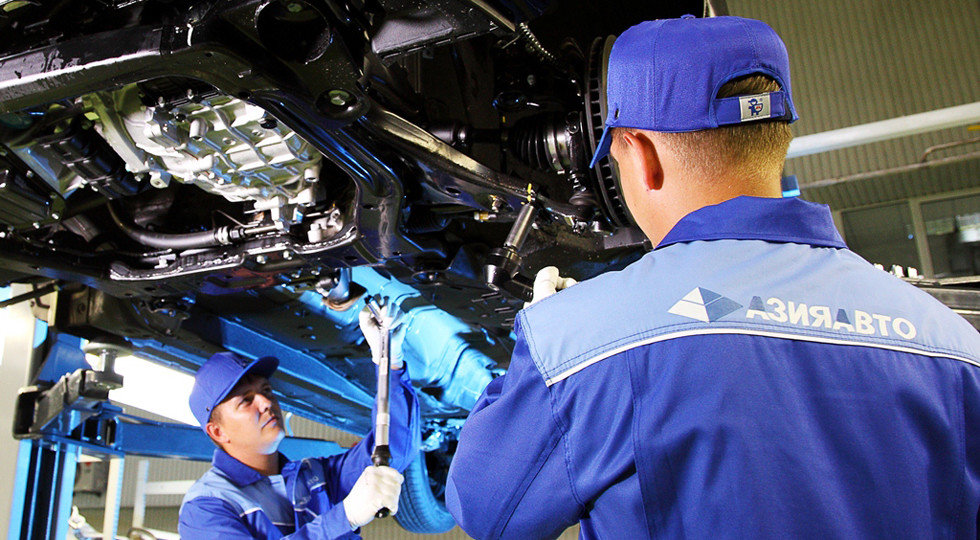Kazakhstan’s automotive industry experienced a rapid rise in the first quarter of 2017, as sales in domestic vehicles grew by ten percent, according to the Union of Automobile Industry Enterprises of Kazakhstan, known as KazAvtoProm.
KazAvtoProm reported that over the past three months the country churned out 3,405 vehicles, including cars, trucks, buses and special vehicles, compared to 839 vehicles in the same period last year.
Oleg Alferov, Chairman of the Board at KazAvtoProm, said this is all welcomed news because the sector had experienced a two-year decline in sales and production.
“The car output in Kazakhstan is growing for the third month in a row, as sales show growth over two quarters. And the demand for the local assembly of cars is recovering much faster than the market as a whole,” Alferov explained in a statement issued on April 20.
“If a year ago only 19 percent of buyers chose KazAvtoProm’s offers, today every third car purchased in the country has a Kazakh origin,” the statement continues.
Kazakhstani automotive manufacturers include companies such as AziaAvto, Saryarka AvtoProm LLP and AllurGroup. The country’s first and largest car manufacturer, AziaAvto, produces cars in accordance with agreements signed with Germany’s Volkswagen Group, the US’ General Motors, the Franco-Japanese-Russian alliance Renault-Nissan-AvtoVAZ, and South Korea’s KIA Motors. Saryarka AvtoProm LLP produces Hyundai, Iveco, Toyota, JAC and SsangYoung brands locally.
With a population of over 18 million, Kazakhstan is the Caspian region’s second largest and second wealthiest country after Russia. While its economy is largely dependent upon oil and natural gas resources, its nascent automobile industry is only a fraction of the national economy. In 2015 it represented 1.39 percent of the country’s manufacturing sector, down from a six-year high in 2014, when it stood at 3.08 percent.
According to KazAvtoProm’s data, throughout the first three months of 2017, Kazakhstan’s strength was passenger vehicles. It produced 3,095 units, compared to 428 units in the same period of 2016. Sales stood at 2,161, indicating that 29 percent of car buyers preferred locally made.
Alferov explained that the existing difference between supply and demand reflects the efforts of manufacturers to close a gap that had emerged as a result of a sharp drop in production, which was caused by multiple factors. Kazakhstan, whose economy relies on the oil and gas industry, experienced hard times after a sharp fall in oil prices in 2014.
"In 2016, the output volumes of Kazakhstan car factories were reduced to a minimum of 11,000 units. The pace of production fell back to the level of 2011. Meanwhile, consumer activity was slow and unstable, but restored,” Alferov told Sputnik Kazakhstan, saying that at the end of last year consumer demand for cars resumed, reaching $870 million for the year. He further added that there was a shortage for a number of cars, including such budget cars as LADA, Kia and Skoda.
In 2016, auto dealers in Kazakhstan sold a total of 43,000 vehicles, a number that includes both domestically produced and foreign made cars. This represents more than a 53 percent decrease from sales a year earlier, which stood over 94,000.
According to KazAvtoProm, Russia’s LADA tops the rating of the most popular brands in the first three months of 2017. LADA is followed by KIA (Korean), Hyundai (South Korean), Chevrolet (American), JAC (Chinese), Skoda (Czech), SsangYong (South Korean), Peugeot (French), Geely (Chinese) and Toyota (Japanese).
At the same time, total sales of new cars fell by one-third compared to the first quarter of last year, according to KazAvtoProm, due to high prices, which are a result of the devaluation of the national currency, the tenge.
Earlier this year Kazakhstan’s Ambassador to Uzbekistan Erik Utembayev told Sputnik Uzbekistan that the country is considering the possibility of producing Uzbekistani cars, under the brand Ravon, due to their competitive pricing.
“The price range of the Ravon model will vary on average between 2.6 and 2.7 million tenge ($8,258 - 8,604), while LADA Priora, which is considered the cheapest car, costs 3.5 million tenges ($11,153),” Utembayev explained.







 Armenian sappers commenced on Monday mine-clearance operations in the territories adjacent to the Saint Mary Church in village of Voskepar (Armenia...
Armenian sappers commenced on Monday mine-clearance operations in the territories adjacent to the Saint Mary Church in village of Voskepar (Armenia...
 The Mine Action Agency of Azerbaijan (ANAMA) reported on Thursday the discovery of a significant amount of explosives in the Khojavand district of ...
The Mine Action Agency of Azerbaijan (ANAMA) reported on Thursday the discovery of a significant amount of explosives in the Khojavand district of ...
 Russian peacekeeping forces, deployed in the Karabakh (Garabagh) region of Azerbaijan since 2020, have commenced their withdrawal from the area.
Russian peacekeeping forces, deployed in the Karabakh (Garabagh) region of Azerbaijan since 2020, have commenced their withdrawal from the area.
 Russian Foreign Minister Sergei Lavrov has reasserted that Moscow has no intentions to stop the fighting in Ukraine, even if peace talks commence.
Russian Foreign Minister Sergei Lavrov has reasserted that Moscow has no intentions to stop the fighting in Ukraine, even if peace talks commence.
 Iran’s Foreign Minister, Hossein Amir-Abdollahian, has labeled a foiled Israeli drone attack in certain parts of the country as a "failure" for Isr...
Iran’s Foreign Minister, Hossein Amir-Abdollahian, has labeled a foiled Israeli drone attack in certain parts of the country as a "failure" for Isr...



